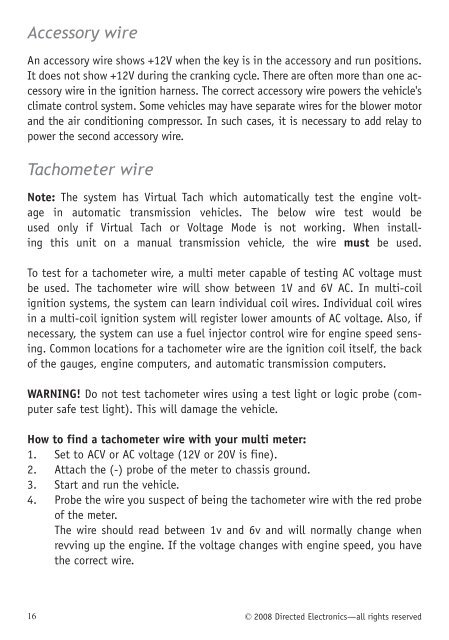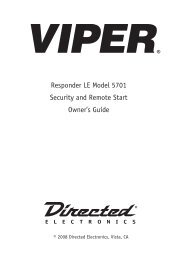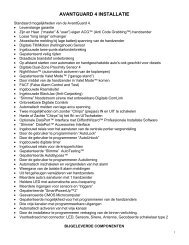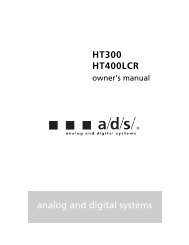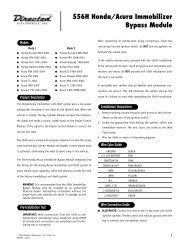Responder LE Model 5701 Security and Remote Start Installation ...
Responder LE Model 5701 Security and Remote Start Installation ...
Responder LE Model 5701 Security and Remote Start Installation ...
You also want an ePaper? Increase the reach of your titles
YUMPU automatically turns print PDFs into web optimized ePapers that Google loves.
Accessory wire<br />
An accessory wire shows +12V when the key is in the accessory <strong>and</strong> run positions.<br />
It does not show +12V during the cranking cycle. There are often more than one accessory<br />
wire in the ignition harness. The correct accessory wire powers the vehicle's<br />
climate control system. Some vehicles may have separate wires for the blower motor<br />
<strong>and</strong> the air conditioning compressor. In such cases, it is necessary to add relay to<br />
power the second accessory wire.<br />
Tachometer wire<br />
Note: The system has Virtual Tach which automatically test the engine voltage<br />
in automatic transmission vehicles. The below wire test would be<br />
used only if Virtual Tach or Voltage Mode is not working. When installing<br />
this unit on a manual transmission vehicle, the wire must be used.<br />
To test for a tachometer wire, a multi meter capable of testing AC voltage must<br />
be used. The tachometer wire will show between 1V <strong>and</strong> 6V AC. In multi-coil<br />
ignition systems, the system can learn individual coil wires. Individual coil wires<br />
in a multi-coil ignition system will register lower amounts of AC voltage. Also, if<br />
necessary, the system can use a fuel injector control wire for engine speed sensing.<br />
Common locations for a tachometer wire are the ignition coil itself, the back<br />
of the gauges, engine computers, <strong>and</strong> automatic transmission computers.<br />
WARNING! Do not test tachometer wires using a test light or logic probe (computer<br />
safe test light). This will damage the vehicle.<br />
How to find a tachometer wire with your multi meter:<br />
1. Set to ACV or AC voltage (12V or 20V is fine).<br />
2. Attach the (-) probe of the meter to chassis ground.<br />
3. <strong>Start</strong> <strong>and</strong> run the vehicle.<br />
4. Probe the wire you suspect of being the tachometer wire with the red probe<br />
of the meter.<br />
The wire should read between 1v <strong>and</strong> 6v <strong>and</strong> will normally change when<br />
revving up the engine. If the voltage changes with engine speed, you have<br />
the correct wire.<br />
16<br />
© 2008 Directed Electronics—all rights reserved


